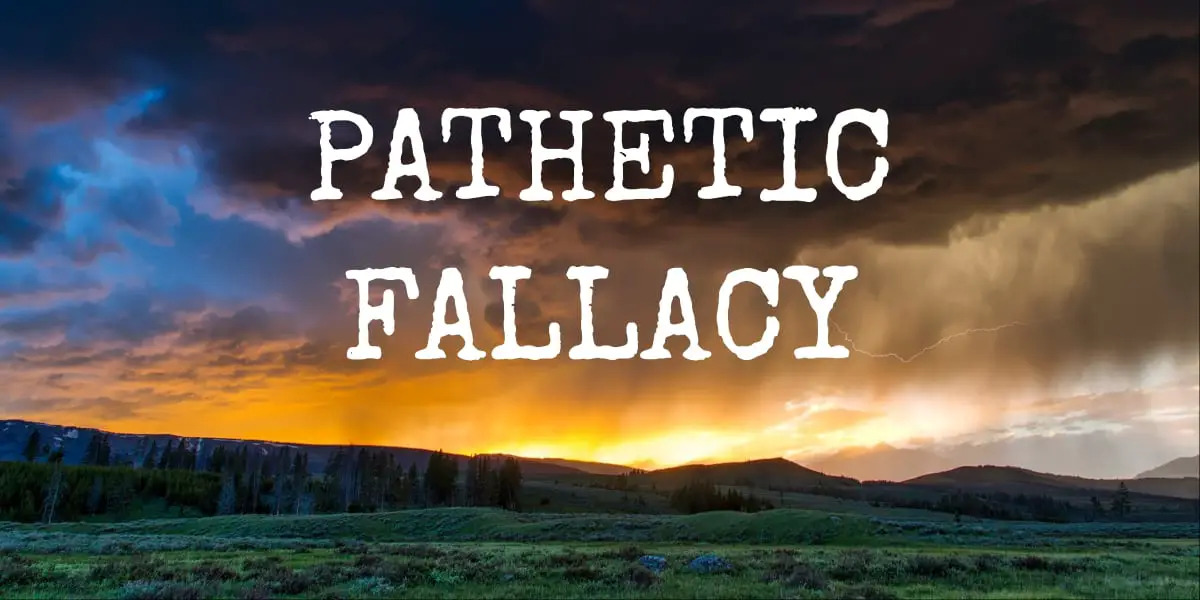What is pathetic fallacy?
Pathetic fallacy is a poetic device where, for the purpose of creating symbolic value or another higher-order creative expression, we attribute human emotions to items which don’t feel emotions.
Edit Torrent
A Short History of Pathetic Fallacy
The term ‘pathetic fallacy’ was coined in 1856 by a man called John Ruskin (an art critic). He meant it as an insult. For John, the most important thing about art was ‘truth’. He was getting a little sick and tired of art (and descriptions in books) which did not represent the ‘true appearances’ of things. He hated when poets let their ’emotions’ get in the way.
As an example of pathetic fallacy, John Ruskin offered the following:
The one red leaf, the last of its clan,
That dances as often as dance it can.
from Christabel by Coleridge
He said that was ‘morbid’. Of course, this makes almost every author of fictional prose and poetry throughout history ‘morbid’, including Shakespeare. Nowadays the phrase ‘pathetic fallacy’ is used in a neutral way.
How does pathetic fallacy create atmosphere?
Pathetic fallacy is an important tool when writing melodrama, and is also a tool when writing a mood piece. An example of a mood piece would be Poe’s “The Fall of the House of Usher”. Mood pieces emphasise atmosphere over plot. There’s often a lot of surrealism and loose allegory. “Tales of Terror” are often mood pieces. These are a subcategory of horror.
Therefore, in a mood piece, the setting ‘comes alive’. The author picks characters, settings and objects to represent an idea and reinforce it. Terror is invoked when the physical surroundings appear nearly alive.
When the person feels gloomy the whole world looks drab. In fiction, a character is presumed to feel gloomy because the whole world IS drab.
This is the kind of backwards emotional projection we’re talking about.
On the other end of the emotional scale, utopias in children’s stories tend to be sunny and temperate, symbolising the characters’ emotional state.
How is pathetic fallacy different from personification?
But hang on. Isn’t that red leaf example above simply called ‘personification’? (When inanimate objects are described using the emotions and actions of people?)
This is straight out of M.H. Abrams, the 1990s literature student’s bible:
“Pathetic fallacy” is now used, for the most part, as a neutral name for a very common phenomenon in descriptive poetry, in which the ascription of human traits to inanimate nature is less formal and more indirect than in the figure called personification.
A Glossary of Literary Terms, 7th Ed.
Though it’s rarely used in this way outside the actual phrase ‘pathetic fallacy’, pathetic is the adjective of ‘pathos’.
How does pathetic fallacy create tension?
Anytime a setting ‘comes alive’, or is turned into a character in its own right, there is now the potential for a setting to feel more like an active rather than a passive opponent for the main character.
Pathetic fallacy is one trick writers use to make a setting feel alive. There are many other ways.
Pathetic Fallacy And The Weather

Across all forms of art, Pathetic Fallacy is frequently used in regards to weather.
A character feels sad and it rains. (It happens in Chicken Run, but there are a million other examples.)
It also happens in a song by Simple Minds.
And here’s a Motown example, if preferred:
A character feels threatened and there’s a storm. (Storms tend to be more than just atmospheric.)
and so on.
I really like this kind of pathetic fallacy. Especially storms. Love me a storm. (Except when a lightning bolt renders your TV aerial useless. Not a fan of that.)
It was a dark and stormy night.
A Wrinkle in Time by Madeleine L’Engle
Notes below are from The Book Show – interview with John Mullan
Ramona Koval: There’s so many things in this book that I wanted to talk to you about. You say that the British novel took a long time to discover a sense of place, and the discovery of weather in the novel only happened in the 19th century. What was going on?
John Mullan: Both those things, if you read novels, I think the sense of place…if you read novels until the early 19th century, apart from London and occasionally Bath (these are the two places you go to in 18th century novels which are distinct), all the other places are sort of generic places; there’s the countryside, there’s the open road and there are inns where you stop and every inn is just like every other inn, and every village is just a sort of general English village.
And then in the early 19th century, the person who really did it actually was Walter Scott, and he made Lowland Scotland and Edinburgh a kind of place that people right the way throughout Europe thought that they knew. It was picturesque and it was romantic and it was associated with legends and ruins and old stories, and his novels were full of old stories, and he made at least part of Scotland a place that in the imagination readers could be tourists of, almost. So before, more famously at the end of the 19th century, Thomas Hardy did that for Wessex, before Scott the idea that particular places apart from London could live in the imagination wasn’t something novelists thought of.
After Scott, the sense of place became something that novelists routinely did and now we expect it, almost. We expect it as something that novelists are careful about, getting their setting right. And equally weather. I think it was Jane Austen who discovered weather, really. Until she came along, occasionally in novels when somebody has to take shelter there’s a big storm, but the sense that novelists are the kind of people who notice the small details of ordinary life didn’t include doing the weather. Jane Austen…one of the many ways in which she…she’s thought of as rather a staid writer but in fact she’s incredibly innovative, I think, and one of the many little things she did was she discovered how a novelist could use the weather in their plot.
Over and over again it happens, and I’ll mention one small example; at the end of what I think is her greatest novel, one of the greatest novels ever, Emma, there’s a scene where Emma and Mr Knightly basically declare their love for each other. This is the climax of the novel, a climax of a novel which was full of misunderstandings and people not saying what they really feel. They do this because the weather suddenly changes. They’re going to take a walk around the garden and the weather looks inclement so they’re not going to do it, and you’re led to understand by the narrative that if they hadn’t taken this walk round the garden, if the weather hadn’t suddenly cleared up, they wouldn’t have been able to have this conversation, and it’s actually quite possible that they would have gone on feeling these things for each other and yet not declaring them and you wouldn’t have had the happy ending. It’s as if suddenly, miraculously the clouds, on a typical English day, clear away, the sun comes out, we’ll go for the walk, we’ll have the happy ending.
PATHETIC FALLACY AND NEARBY OBJECTS
I tore all the roses off a single sad bush and threw them, one after the other, into the angry sea.
We Were Liars by e. lockhart (2014). Lockhart ends a chapter with this. The first person narrator has just realised the boy she likes has picked a flower for another girl instead.
As you can see, pathetic fallacy is still used. Sometimes it goes by different terms.
Empathic Universe. A common feature of melodramatic or romantic writing, it occurs when the author customizes the environment to match the protagonist’s moods. Lightning flashes as a Gothic horror opens; fog descends when the protagonist is confused; rain falls on funerals but the sun returns when the mourner becomes hopeful. Usually overused. (CSFW: David Smith)
Glossary of Terms Useful In Critiquing Science Fiction
Organ music. Details which seek to countersink an emotional response in the reader even before anything happens (such as crackling lightning and rain outside a window before anyone’s murdered). (CSFW: David Smith)
Glossary of Terms Useful In Critiquing Science Fiction
But as mentioned by EditTorrent, when making use of this figure, we need to be careful of our sentence structures, and doubly careful about accidentally writing cliché.
That’s why it’s important to know what this is called.

